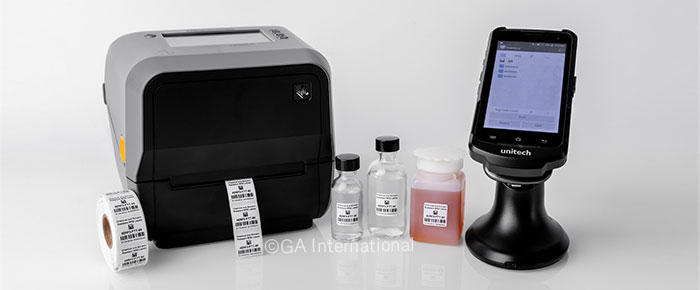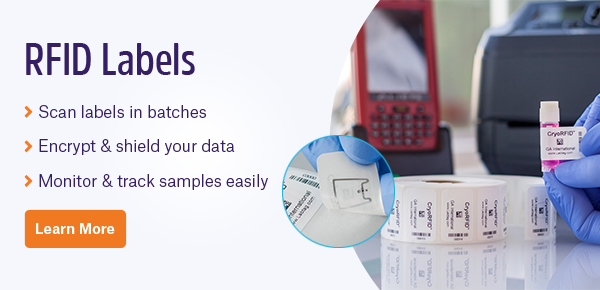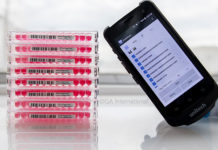
Radio-frequency identification (RFID) is one of the fastest developing technologies used to identify laboratory samples and reagents. Though it’s been around since the 1970s, it’s only recently that the research, healthcare, and pharmaceutical sectors have begun to widely implement RFID-based systems. Because of the surge in their use, it’s likely that many of these systems need at least a little troubleshooting. Below are some helpful tips to get your RFID system running smoothly and keep it reading samples consistently.
Selecting the label or tag
Not all RFID labels have the same resistance to chemicals and temperature variations. Selecting the incorrect label material may cause the label to fail, resulting in signal loss. When choosing what type of label your inlay will be included in, always consider the environmental conditions it will be exposed to. Ensure a cryogenic solution is used for samples stored in low temperatures, including low-temperature freezers and liquid nitrogen tanks. Cryo RFID solutions are available that can even transmit a signal while immersed in liquid nitrogen or for identifying already frozen containers. Chemical-resistant RFID labels should be used for applications where samples are exposed to harsh chemicals, including histology applications and xylene immersion protocols, while heat-resistant RFID labels are recommended for use in steam autoclaves.
Check for interference
Cross interference between signals is one of the most common reasons why RFID chips fail to scan correctly. WiFi networks and other systems that broadcast radio waves, like Bluetooth, can interfere with RFID signals if they share common or adjacent frequency bands. Even some medical tools, like wireless endoscopes, can potentially interfere. The first thing that should be done when troubleshooting read errors is to determine the number of radio wave-emitting devices in the area and their frequencies. It’s also possible that two RFID readers are installed in close proximity to one another. To minimize interference from another reader, place it at least one meter away, if not further.
Choice of material
The material of the object tagged or labeled with an RFID chip plays an integral role in successfully implementing an RFID system. High-density materials, like metal, can affect transmission characteristics, leading to poor readability. Metal is particularly difficult to tag because it can detune antennas and reflect signals, creating interference.
Aqueous solutions are another type of substance that can affect transmission. Though you shouldn’t have an issue labeling tubes with RFID, even if they contain water, you might have problems if the tag remains immersed in liquid or if you’re directly holding the tag with your hand. Some RFID labels can emit a signal while immersed in liquids, though there is generally a limit to how deep.
Tag density
Stacking tags next to each other or on top of each other is another easy way to obtain reading errors. This is especially true for UHF tags, which perform poorly compared with HF antennas when stacked on top of each other. Prior to selecting tags, it’s recommended to assess the distance each tag will remain from one another to determine an optimal RFID solution.
Reader placement
Poor readability can also occur when the reader is located too far away from the target or when objects are located between the reader and the tags. Reading distance can be influenced by many factors, including environmental surroundings, reader power and sensitivity, tag sensitivity, and tuning, among other factors.
If an error occurs, it’s always a good idea to have a backup plan. With new technology that allows RFID inlays to be generated on nearly any type of label, it’s useful to print labels (or tags) with barcodes as a secondary measure, ideally with a thermal-transfer printer, to provide optimal resistance against extreme temperature and chemical exposure. For added convenience, thermal-transfer RFID printers allow labels or tags to be simultaneously printed and encoded. If the RFID signal cannot be scanned, barcodes can be used to identify the sample; this is especially important for time-sensitive protocols where any error in identification can ruin a workflow.
To prevent errors from occurring in the first place, it’s crucial to always test your RFID system prior to wholesale implementation. To do this, it’s recommended to partner with a distributor who can provide samples; that way, the system can be integrated without commitment, ensuring samples are read consistently and accurately from the start.
LabTAG by GA International is a leading manufacturer of high-performance specialty labels and a supplier of identification solutions used in research and medical labs as well as healthcare institutions.



